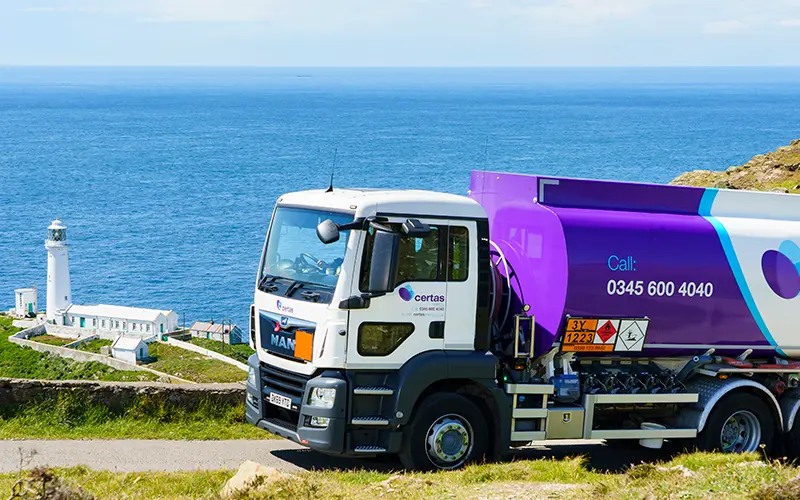If you’re thinking of updating your heating system, installing a heating oil tank can be a cost-effective way of keeping your bills down and your house warm. Around 1.1m households in the UK are not connected to the national grid. With that figure steadily rising, we’ve created a simple heating oil tank installation guide with all the expert advice you need to get started.
Things to consider when installing an oil tank
Modern oil storage tanks come in all shapes and sizes, and are made using either plastic or steel. The size and type of tank you use will depend entirely on your circumstances, but it’s important to get an idea of what your options are with domestic tank installation.
What type of oil tank will I need?
Single-skinned tanks
A single skin oil tank is a container which doesn’t have a bund or catchment area, meaning the fuel would be released into the environment in the event of a spillage. While single-skinned tanks are the cheapest option, these are subject to stricter regulations.
Inegrally-bunded tanks
These tanks are made up of two layers – an inner tank and an outer tank (bund) which acts as a secondary containment. These oil tanks contain any leaks or spillage should they occur, while the outer layer also provides added protection from the elements.
Where should I put my heating oil tank?
Before installing your domestic oil tank, you need to consider its location. OFTEC’s health and safety regulations state that your tank should be positioned:
- 1.8m away from non-fire related eaves of a building
- 1.8m away from non-fire buildings or structures (e.g. garden sheds)
- 1.8m away from openings (such as doors or windows) in a fire rated building or structure (e.g. brick-built house/garage)
- 1.8m away from liquid fuel appliance flue terminals
- 760mm away from non-fire rated boundary, such as a wooden boundary fence
- 600mm away from screening (e.g. trellis and foliage) that does not form part of the boundary.
In addition to these guidelines, you should also factor in access for your delivery driver. Doing so will ensure they can safely deliver your oil tank parts and refuel your tank whenever your supply is running low.
Ideally, your tank should be reachable from the road without requiring passage through your property. Having this accessibility means that our drivers won’t need to drag a hose through your home, allowing for fuel deliveries to be made even when you are not present.
How much heating oil do I need?
1,000 litres of heating oil can typically last for up to one year, but this can depend on several factors, including:
- Your house size
- How often you use your heating
- How efficient your boiler is
All tanks should be fitted with a smart gauge to measure how much oil is left. It’s worth keeping a note of this to see how much fuel you use over a given period. Also, to prevent overflow, you should keep your tank filled to around 80-90% capacity.
The importance of proper heating oil tank installation
Domestic heating oil tank installations need to comply with government regulations before any work takes place, with both environmental and fire hazards to consider. It is recommended that your tank is manufactured to OFTEC standards, with an OFTEC registered technician on-hand to carry out a full risk assessment.
When installing your tank, the base needs to provide continual structural support in all-seasons. The base should be:
- Strong enough to support the weight of the tank and its contents
- Non-combustible
- Constructed out of concrete, paving stones, or stonework
- Big enough to extend 300mm beyond all sides of the tank
A full list of rules and regulations can be found on gov.uk, as well as industry standards agency OFTEC.
How to maintain your domestic heating oil tank
Once you’ve installed your new tank and heating system, keeping them well maintained will ensure they are running as efficiently as possible. Doing this will help keep your costs down, as well as reducing the risk of breakdown. Any oil spills and leaks can have a detrimental impact on the environment, which can be extremely costly to fix.
As the UK’s biggest heating oil supplier, we understand it’s important to give your tank some TLC. When you purchase a tank with us, we’ll ensure you have plenty of advice to make sure that it will last longer.
How often should my oil tank be serviced?
Your tank should be serviced once a year by an OFTEC registered engineer. In addition to its annual service, there are some simple checks you can do to make sure your tank is in good working order. Some signs you should look for include:
- Cracks and splits
- Rust
- Bulging and deep scratches
- Faulty gauges and alarms
- Sudden increases in oil usage
- A stronger smell of oil
In addition to this, you should also make sure that access to and around the tank is clear, as well as keeping vents and gauges protected from rainwater.
Find out what to expect and how to prepare for your tank and boiler service.
How to remove old tanks
Any old tank and pipework that is no longer in use should be decommissioned by a professional. Your technician should be able to remove your old tank upon installation of your new one, as well as any remaining pipework. If the pipework cannot be removed, it should be permanently capped to prevent further use.
We hope our heating oil tank installation guide has given you the confidence to begin the process with ease. By following our advice, you’ll be well on your way to a successful installation and a warm, cosy home. For further guidance, get in touch with our friendly team who will be happy to help.
Once you’ve installed your new tank, you need to keep it running. Find out how much heating oil you should purchase for your household.
TAKE CONTROL OF YOUR FLEETS FUEL
Ready to start fuelling your business' success?
Steamline your fleet operations, control costs, and experience the benefits of Certas Energy Fuel Cards. Get in touch to start saving today.




